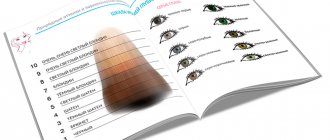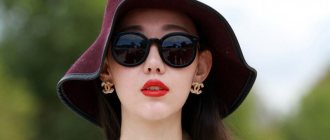What should school fashion wear be like?
Latest school fashion trends
- School fashion for girls
- School fashion for boys
School uniform in accordance with the age of the student
Appearance plays an important role for every school-age child, and especially for a teenager. One of the necessary elements of every student's wardrobe is a fashionable school uniform. Despite the fact that many argue about the need and importance of school uniforms, they do not lose popularity, and jeans, beloved by all children, are banned in many educational institutions.
In addition, it has been proven that uniforms help students be more disciplined and in a working mood, and if the school uniform is also fashionable, then wearing it is a pleasure.
What should school fashion wear be like?
If you need fashionable clothes for school, don't rush to grab the first one you come across.
When choosing a uniform for your child, be guided by the following principles:
- Find out from the class teacher what type of school uniform is required;
- Be careful when selecting the size. The school uniform should not restrict the child’s movements or put pressure in any place. Although buying a school uniform to grow into is a good way to save money, it is better not to do it. In clothes several sizes too large, the child will look ridiculous, and when it fits him, its appearance will no longer be ideal;
- Buy several things for your child at once so that you can alternate wearing them;
- If the purpose of your purchase is a fashionable school uniform for boys, give preference to jacket models with two buttons if the child is fat and short; and, conversely, choose jackets with more buttons if the child is tall and thin.
- If your child does not like to wear jackets, use a trick and choose an element of school fashion clothing such as a vest. It can be combined with various shirts, and, if necessary, with a tie.
- Coordinate your choice with the choice of the child; it is important that the clothes for school are not only fashionable, beautiful and elegant, but also that the student likes them. Buy clothes with your child.
In addition, a fashionable school uniform for teenagers must meet the following requirements:
- Color spectrum. It is recommended not to get carried away with bright colors, since the shape should not distract from study;
- Label. Carefully read the information on the label and refuse to purchase if it indicates the recommended washing method - dry cleaning. It is better if the school uniform can be washed and ironed without fear of ruining it.
- Smell. An unpleasant, sharp chemical smell should immediately alert you, because it may indicate the presence of harmful substances in the fabric of the product;
- Lining. Since it is the lining that comes into contact with the child’s skin, it should only be made of natural fabric;
- Cut. When choosing a school uniform, avoid tight models, such as trousers or skirts, which will put pressure on your stomach; vests that can compress the chest, preventing the child from moving and causing discomfort;
- Documentation. Upon your first request, the seller is obliged to provide a certificate of conformity and a declaration of conformity for the product.
- Fabric of the product. Things should consist of at least half natural materials. Synthetic fabrics do not allow the skin to breathe and lead to profuse sweating. However, do not be afraid of the small synthetic content in the fabric - artificial materials give the product strength and do not allow it to wrinkle.
- Price. Remember that a quality item will not be sold cheap. In pursuit of savings, many parents forget that the health and comfort of their child is more important than the few hundred saved. If you need a fashionable school uniform at a price lower than in stores, you can place a collective order for items from the entire class or even the school.
Fashionable school uniform
Uniform school uniform 2014-2015
A uniform school uniform worries children and their parents. Is it necessary? If yes, what should it be? How much will it cost?
How many disputes and different opinions we have now. Some people believe that school uniforms are necessary. Others are of the opinion that it harms the harmonious development of the individual. There are people who believe that school uniforms are an invention of the Soviet leadership. The uniform school uniform in Russia has a rich history. Until 1917, only children of wealthy parents who could afford to educate their children in gymnasiums wore uniforms. This was purely a class characteristic. The boys had military-style uniforms, and the girls wore dark, formal dresses. High school students were required to wear uniforms not only within the walls of the educational institution, but also on the street, at home, and during various celebrations.
The exact date of the introduction of school uniforms in Russia is 1834. It was in this year that a law was adopted that approved a separate type of civilian uniform. These included gymnasium and student uniforms. The introduction of uniforms for students in educational institutions of Tsarist Russia is primarily due to the fact that these institutions were state-owned. In those days, all civil servants were required to wear uniforms corresponding to their rank and rank, according to the Table of Ranks. Thus, all teachers in state educational institutions (gymnasiums) wore uniform frock coats. Based on this, it was natural to introduce uniforms for students. The caps were usually light blue with three white edges and a black visor, and a crumpled cap with a broken visor was considered especially chic among boys. In summer, a kolomyanka cover was put on the crown of the cap. In winter, when it was cold, they wore headphones made of black felt on a brown flannel inside. In addition, in cold weather they wore a hood the color of natural camel hair, trimmed with gray braid. Typically, students wore a blue cloth tunic with silver convex buttons, belted with a black lacquered belt with a silver buckle, and black trousers without piping. There was also an exit uniform: a dark blue or dark gray single-breasted uniform with a collar trimmed with silver braid. An invariable attribute of high school students was a backpack. High school students usually did not wear gymnasts, but jackets with a stand-up collar, like a naval jacket. In some gymnasiums, tunics and jackets were not blue, but gray, while trousers were always black. High school students also had an exit uniform - a uniform, dark blue or dark gray, single-breasted, with a collar trimmed with silver braid. This uniform was worn both with a belt and without a belt (outside of school). A starched collar was worn with the uniform. The overcoat was an officer's type, light gray, double-breasted, with silver buttons, blue buttonholes, the color of the cap, with white piping and buttons. The overcoats were cold and padded, with a quilted gray lining. Instead of a scarf, they wore a black cloth bib, like sailors. Primary school students were allowed a black astrakhan collar in winter. According to the unwritten rules, a high school student on the street was required to hide the number of the high school in which he studied, so that the high school student who committed an offense could remain unidentified. The number had to be broken from the cap, and a school student who did not do this was brutally persecuted by his comrades. For the same purpose, it turned over and hid the belt buckle. Until 1917, the style of the uniform changed several times (1855, 1868, 1896 and 1913) - according to fashion trends. But all this time the boys’ uniform fluctuated on the verge of a civilian-military suit.
The regulations on gymnasium uniforms for girls were approved in 1896. To attend the gymnasium, they had three types of clothing provided by the charter. Firstly, the “mandatory uniform for daily attendance”, which consisted of a brown woolen dress and a black woolen apron. The charter required “to keep the dress clean and tidy, not to wear it at home, to iron it daily and to keep the white collar clean.” The dress uniform consisted of the same dress, a white apron and an elegant lace collar. In full dress uniform, schoolgirls attended the theater and the Elenin Church on holidays, and wore it to Christmas and New Year's parties. Also, “no one was forbidden to have a separate dress of any model and cut if the parents’ means allowed such luxury.”
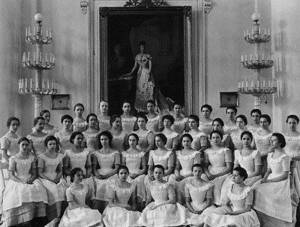
Pupils of the Smolny Institute had to wear dresses in colors that corresponded to a certain age. Girls from 6 to 9 years old wore brown dresses, from 9 to 12 years old blue, from 12 to 15 years old gray and from 15 to 18 years old - white. The dresses were closed (“deaf”), one-color, of the simplest cut. After the October Revolution, the uniform was abolished, as were the gymnasiums. The children of peasants, workers, and office workers studied in the newly organized educational institutions, and since there was famine and devastation in the country where the civil war was going on, the main thing was to feed the children and teach them to read and write. Therefore, no attention was paid to school uniforms and children wore casual clothes.
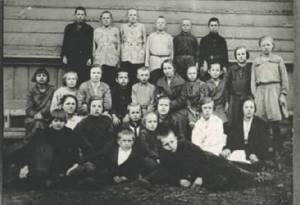
From the memoirs of Valentina Savitskaya, a 1909 graduate of gymnasium No. 36: “The old uniform was considered a symbol of belonging to the upper classes (there was even a contemptuous nickname for a sentimental girl - “gymnasium student”). It was believed that the uniform symbolizes the lack of freedom, the humiliated, servile position of the student. But this refusal of form had another, more understandable reason - poverty. The students went to school in what their parents could provide them with.”
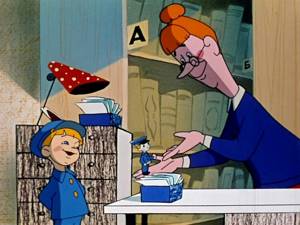
However, over time, when the era of experiments gave way to other realities, it was decided to return to the former image - to brown formal dresses, aprons, student jackets and turn-down collars. This happened in 1948, during the period of universal “uniforming,” when department after department put on uniforms. The 1948 uniform actually copied the style of the classical gymnasium uniform - in color, cut, and accessories.
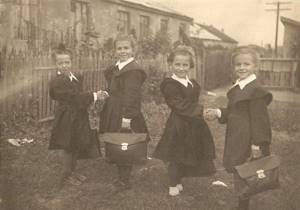
The boys were dressed in gray military tunics with a stand-up collar, five buttons, and two welt pockets with flaps on the chest. An element of the school uniform was also a belt with a buckle and a cap with a leather visor, which the boys wore on the street. At the same time, symbols became an attribute of youth students: pioneers had a red tie, Komsomol members and Octoberists had a badge on their chest.
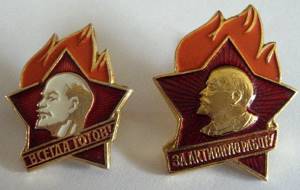
Even the hairstyle had to meet the requirements of Puritan morality - “model haircuts” were strictly prohibited until the end of the 1950s, not to mention hair coloring. Girls always wore braids with bows. The school uniform of the era of I.V. Stalin can be seen in the films “First-Grader,” “Alyosha Ptitsyn Develops Character,” and “Vasyok Trubachev and His Comrades.” This uniform survived until the end of the 1962 school year. On September 1, 1962, first-graders boys went to school in a new uniform - without caps with a cockade, without waist belts with a massive buckle, without tunics. The uniform for girls has remained virtually unchanged.
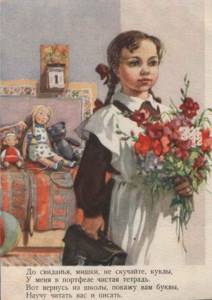
In 1973, a new school uniform reform took place. A new uniform for boys appeared: it was a blue suit made of wool blend, decorated with an emblem and five aluminum buttons, cuffs and the same two pockets with flaps on the chest. For girls, nothing changed again, and then mothers-needlewomen sewed black aprons for their beauties from fine wool, and white aprons from silk and cambric, decorated with lace.
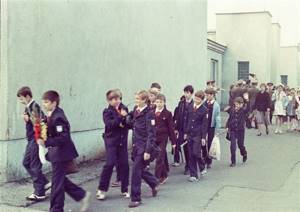
In the early 1980s, uniforms for high school students were introduced. (This uniform began to be worn in the eighth grade). Girls from first to seventh grade wore a brown dress, as in the previous period. Only it was not much higher than the knees. In the 1980s, when school uniform enforcement became less strict, some students replaced the standard emblems with military sleeve patches. For girls, a blue three-piece suit was introduced in 1984, consisting of an A-line skirt with pleats at the front, a jacket with patch pockets (without sleeve emblem) and a vest. The skirt could be worn with either a jacket or a vest, or the whole suit at once. In 1988, the wearing of blue trousers in winter was allowed for Leningrad, regions of Siberia and the Far North.
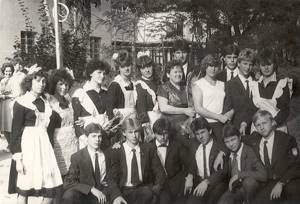
In 1990-91, the wearing of pioneer ties and October badges, as well as Komsomol badges, stopped. The mandatory presence of school uniforms in Russia was abolished in the spring of 1992. A 2005 study found that of 2,200 secondary and private schools in Moscow, approximately 60 percent had introduced or were about to introduce uniforms, while in St. Petersburg the figure was at least 90 percent. The uniform school uniform 2014-2015 in other countries is different from ours: in some places it is more conservative, and in others it is very fashionable and unusual. For example, in Japan, schoolgirls wear sailor suits, called “sailor fuku” there. Their uniform is the standard of teenage fashion for the whole world. Even outside of school, Japanese girls wear something that reminds them of their usual school uniform. In Great Britain, the uniform for schoolchildren is as conservative as possible and is close to the classic style of clothing. Each prestigious school has its own logo, so students are required to come to classes with a “branded” tie.
In the USA, each school decides for itself what items students are allowed to wear. As a rule, tops that reveal the midriff, as well as low-fitting trousers, are prohibited in schools. Jeans, wide trousers with many pockets, T-shirts with graphics - this is what students in American schools prefer.
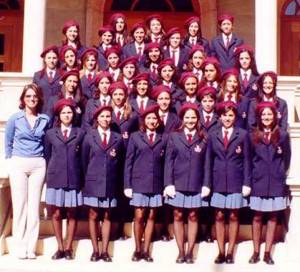
The uniform form 2014-2015 is successfully used in many schools. But the question of its necessity remains open. In most European countries there is also no uniform form; everything is limited to a fairly strict style.
Latest school fashion trends
So, now let’s move directly to the current trends, because fashionable clothes for school are designed to make your child more self-confident, disciplined and neat. And for this it must be truly fashionable.
As for the color scheme, brown, gray, dark blue, burgundy and green have been in fashion for a long time. Shades of beige and brown are calming, while greens and blues help you focus on your studies.
To diversify your everyday look, designers advise including elements with a checkered pattern in your school uniform. Do not get carried away with black and white classics, as it negatively affects the child’s psychological state and tires the eyes.
Don’t think that a school uniform is a boring set of strict combinations. Today, there is a huge variety of styles of school clothes. For example, straight or slightly flared skirts, trousers and straight-cut sundresses, vests, fitted jackets, jackets are fashionable, and high-waisted sundresses and trouser suits are also gaining particular popularity.
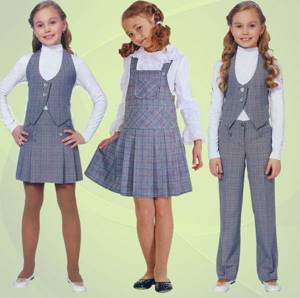
School fashion for girls
Fashionable school clothes for girls are presented in a wide variety of models. It is preferable to buy skirts, jackets, trouser suits (for the cold season), blouses, as well as sundresses or dresses.
The optimal length of a skirt or sundress is mid-knee or slightly lower. A fashionable school uniform for girls will be spoiled by the abundance of decorative elements and decorations, since this clothing should, first of all, be discreet.
School fashion for boys
School fashion for boys also dictates some rules. Boys are recommended to choose vests (classic or knitted), trousers, jackets, as well as shirts, turtlenecks and sweaters (for the cold season).
Fashionable school uniform
Stylish school uniform for middle and high school students 2020-2021
The child spends most of his time at school, so it is important to choose for him not only a comfortable, but also a stylish school uniform. In high school, children try their best to show their individuality, so they often refuse the official school uniform.
The school uniform for high school students 2020-2021 shows trends inherent in adult casual fashion. The trend is for blouses with flounces and ruffles, formal skirts and trousers with patterns. Girls really like collars and jabots, which are attached to the blouse with a button or pins. Such removable details help girls look attractive every day.

The trend of recent school seasons - pleated skirts - also came from adult fashion. They look great on both elementary and high school students.
When it comes to guys, there are also plenty to choose from. In addition to classic trousers, stylish vests and jackets with a pattern and the school logo were added to the looks. Some schools encourage school shorts instead of trousers. Such models are especially relevant in the warm season.
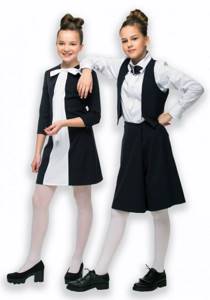
Modern school uniform is a symbiosis of practicality and style. Even despite the original decor and patterns, each model has a strict style and individuality. Below we have prepared for you a photo selection of ideas for a school look, which you can look at together with your child.
School uniform in accordance with the age of the student
Many modern schoolchildren may have a school uniform set consisting of a fairly wide range of different things. When their parents were at school, there was no such variety and freedom of choice.
Despite the fact that most of the recommendations outlined above are universal and are suitable when choosing a uniform for a schoolchild of any age, there are also some tips for parents of children of different age categories.
When choosing a fashionable school uniform for boys and girls of primary school age , you should remember that this age category of children is the most active and mobile. School clothes for them should be strict, disciplining, but not restricting movement.
If you need fashionable school clothes for girls and boys , pay attention to more “adult” models, represented by stylish jackets, bell skirts, more informal sundresses and blouses, and for boys - shirts. Remember that self-expression is very important for teenagers.
When choosing school fashionable clothes for high school students , keep in mind that they are already fully formed individuals and understand fashion trends just as well as you. Give preference to models that are similar to adult business suits: pencil skirts, formal jackets, blouses, trousers with arrows, etc.
If the school rules are not very strict regarding appearance, a fashionable school uniform for teenagers can be diluted with some elements. These could be unusual decorative buttons, stylish shoes, polo T-shirts (if not prohibited); as well as some accessories (for example, belts, belts, cufflinks). Remember that all this should be used in moderation, be appropriate for the student’s age, and look appropriate.
We hope that we have sufficiently armed you with all kinds of tips, and fashionable clothes for school are not a problem for you. We are sure that now you and your child will not be upset because the educational institution insists on wearing a uniform, because even in it you can look stylish.
